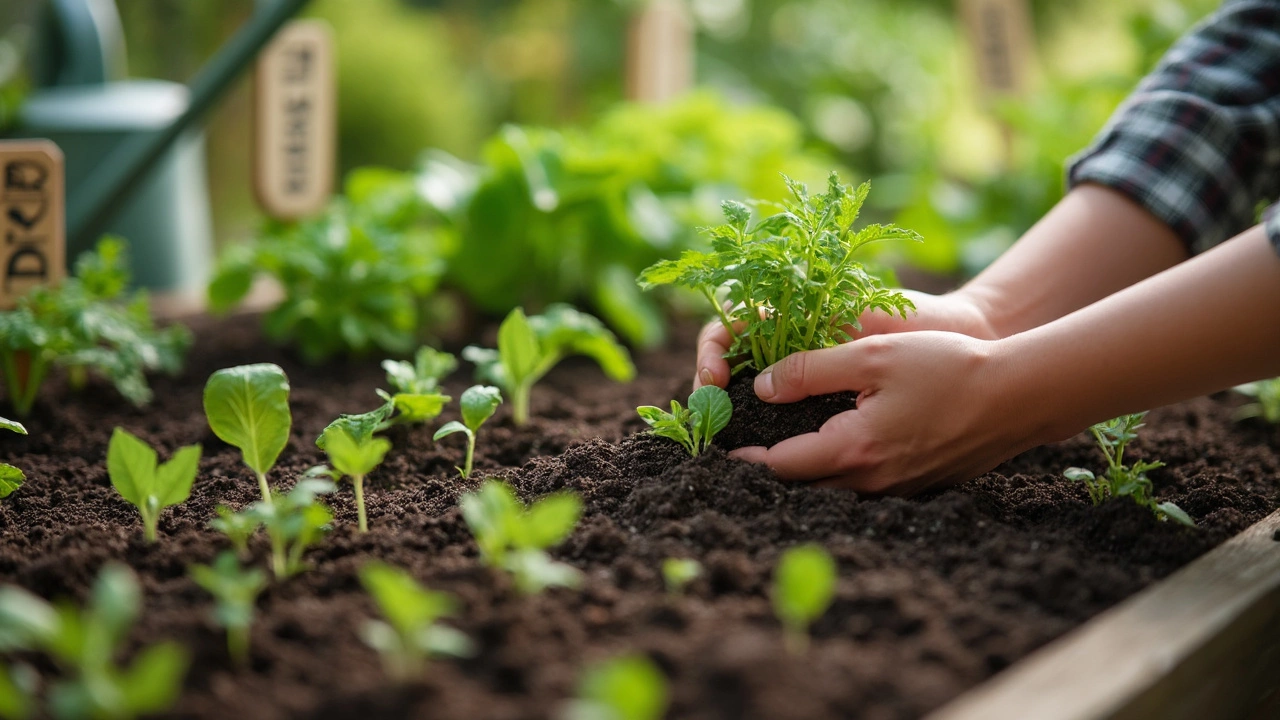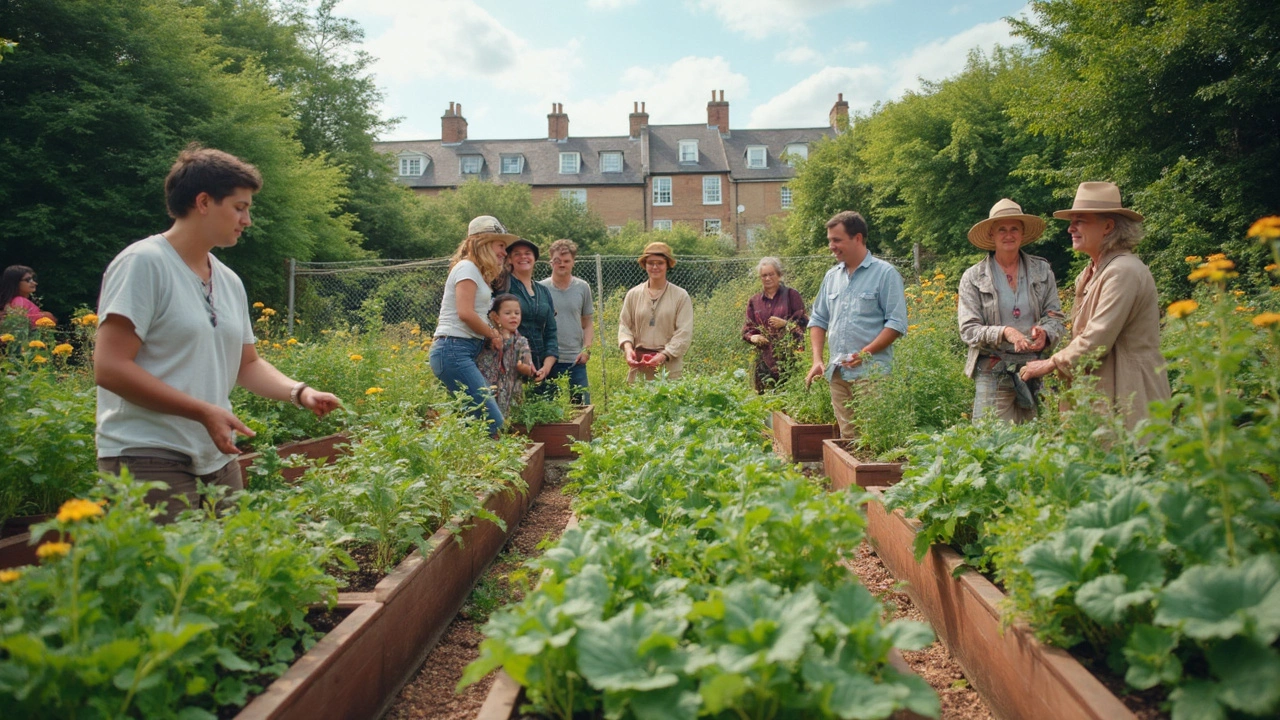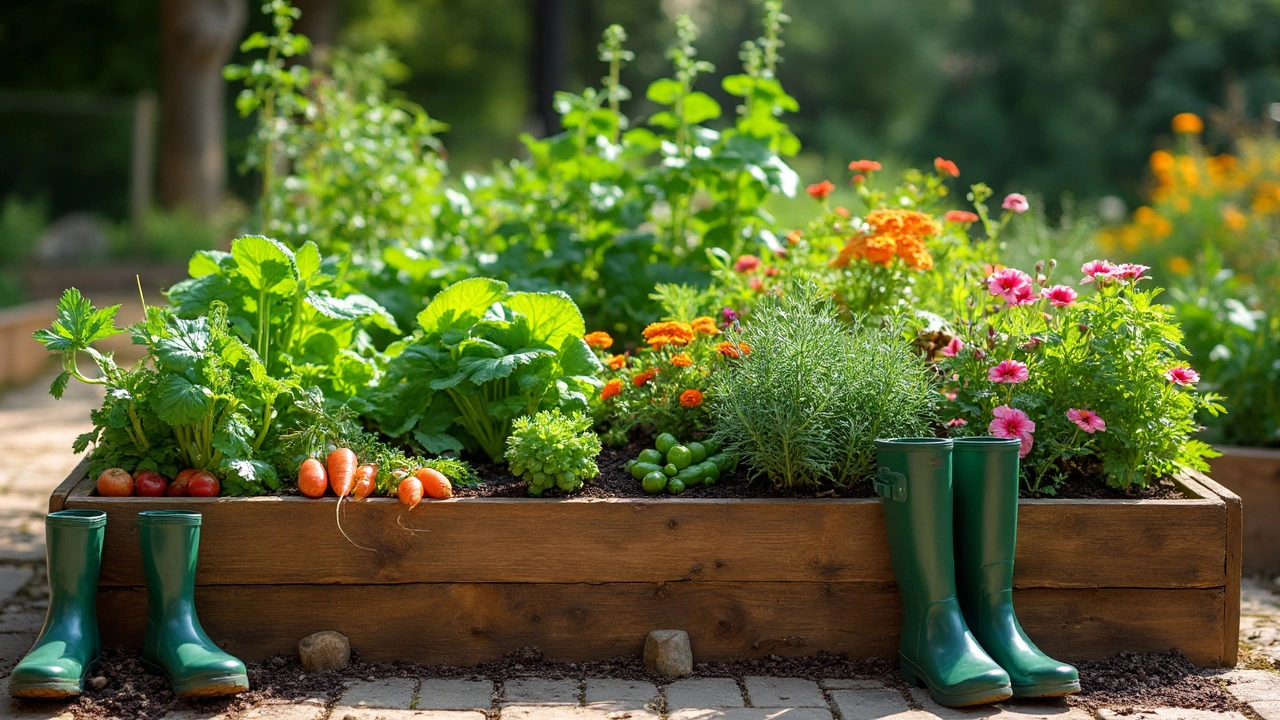So, you're staring at that empty raised garden bed and wondering what will actually crush it in there? You're not alone. Raised beds give you some huge advantages—think warmer soil, fewer weeds, and way more control over drainage. This means you can pick plants that might flop in the ground, but absolutely thrive when they get the VIP treatment up above the lawn.
If you're after results, skip the guesswork. Leafy greens, like lettuce and spinach, go absolutely bonkers in raised beds because the loose soil lets roots spread like crazy, and you can keep the moisture just right. Root veggies—carrots, radishes, beets—grow straighter and sweeter when they're not fighting rocks or clumpy clay. Even tomatoes and peppers grow taller, faster, and give you earlier harvests up here where the soil stays toasty in spring.
And it doesn't stop at veggies. Raised beds make growing fresh basil, chives, and even marigolds so much easier. These plants love the drainage and sun you can dial in up top. But here's the thing: Not every plant will thank you for putting it in a raised bed. We'll get into what to avoid—and what tricks actually make a difference—so you end up with something to brag about instead of a dirt box filled with regrets.
- Why Raised Garden Beds Give You an Edge
- Top Vegetables for Raised Beds
- Best Herbs and Flowers to Grow
- Essential Tips for Maximum Yield
- Mistakes to Avoid
Why Raised Garden Beds Give You an Edge
If you've ever been annoyed with soggy soil, tough clay, or back-breaking weeding, raised garden beds fix a bunch of those headaches fast. They’re kind of a cheat code for backyard gardeners because you control nearly every detail—from the dirt to the drainage.
The most obvious advantage is how much better the soil quality can be. In-ground gardens are stuck with whatever dirt is there, but with a raised garden bed, you load up with the best mix for your plants. Think: fluffy compost, the right amount of sand, or even special blends for veggies like carrots or tomatoes. Roots push through easier, so plants grab more nutrients and water.
Drainage is another big win. If your area gets heavy rain, raised beds let water drain off so your plants don’t drown. At the same time, it’s way easier to keep it moist in dry times since the beds act like giant planters. Also, these beds warm up quicker when spring hits, which means earlier planting and sometimes an extra harvest each season.
Weeds and pests? Raised beds put you back in charge. Since you're starting with fresh soil, weed seeds aren’t lurking everywhere. In a 2018 backyard gardening survey, gardeners with raised beds reported about 64% fewer weeds compared to traditional gardens. Whether you cover the bottom with cardboard, hardware cloth, or landscape fabric, you block out a lot of trouble right from the start.
| Advantage | Why It Matters |
|---|---|
| Soil Control | Pick the ideal mix—better root growth, fewer disease problems |
| Drainage | Reduces root rot, keeps plants healthier after heavy rain |
| Early Warm-up | Faster soil warming = earlier seeds and possible extra harvest |
| Weed Reduction | Less weeding, less back pain, and less chemical use |
Don’t overlook the user-friendly factor either. Beds are often built 12" to 24" high, which saves your knees and makes life easier if you have mobility issues. Plus, you can install drip irrigation, toss on a frost cover, or even build tunnels—all much simpler when the garden’s already organized in neat boxes.
Top Vegetables for Raised Beds
If you want easy wins in your raised garden bed, start with veggies that take full advantage of all that loose, nutrient-rich soil. The most dependable choices usually come down to roots, leafy greens, and fruiting plants that love heat and good drainage. Here’s where these veggies shine and why you should choose them.
- Carrots: Carrots grow longer and straighter in raised beds because the soil stays light and rock-free. This means fewer weird-shaped roots and more crunchy snacks. Tip: pick a variety like 'Nantes' for beginner success.
- Radishes: Fast-growing and unfussy, these guys are perfect for quick harvests. Give them about three weeks, and you’re munching salads boosted by your own work.
- Lettuce and Spinach: These leafy greens hate burning up in dense soil. In raised beds, you can plant them earlier and harvest for months. Try combos—plant a few rows two weeks apart for non-stop salads.
- Tomatoes: Tomatoes love the deep, warm soil in beds and grow roots that go wild when not crammed into pots. Stake them well, and you’ll get bigger yields and early fruit. Cherry tomatoes are usually the most forgiving.
- Peppers: Like tomatoes, peppers prefer things cozy and well-drained. Raised beds help them beat soggy soil, especially after big spring rains.
- Beets: No more chewy, woody beet roots. Raised beds mean better texture and color for these salad stars.
- Zucchini and bush beans: Engage kids with these—they sprout fast, need little fuss, and fill raised beds quickly.
If you want the proof, just look at the numbers. One small study at Cornell University found that raised beds produced double the amount of leaf lettuce per square foot compared to traditional rows, mostly thanks to better soil and easier watering.
| Vegetable | Average Yield (lbs per 10 sq ft) | Bonus Tip |
|---|---|---|
| Carrot | 7 | Loosen soil at least 12 inches deep for best results |
| Radish | 9 | Sow every 10 days for non-stop harvest |
| Lettuce | 10 | Harvest outer leaves to keep the plants producing |
| Tomato (cherry) | 15 | Stake early and prune for best airflow |
| Bell Pepper | 6 | Mulch to keep the root zone warm |
Lisa Bloom, head gardener at Urban Greens Network, puts it simply in her workshops:
“Choose plants that make the most of deep, easy-to-work soil and your raised bed will give back way more than you put in. It’s not just about space – it’s about setting your veggies up for the easiest life possible.”
Stick with these veggies at first and your raised bed will shoulder the heavy lifting. Once you’ve nailed the basics, you can experiment with new varieties, but these crowd-pleasers rarely let you down. Next up—herbs and flowers that actually boost your whole garden’s vibe.

Best Herbs and Flowers to Grow
Raised garden beds are perfect for herbs and flowers, mainly because you get to control the soil and keep everything tidy. If you’ve tried growing herbs in pots or random bits of yard before, you’ll notice an upgrade in growth speed and harvest size in raised beds. The loose, rich mix in these beds is a dream for shallow-rooted herbs.
Basil, chives, parsley, and cilantro all love the consistent moisture and quick drainage you get up here. Basil especially goes wild if you combine good compost with plenty of sun—just pinch the tops weekly, and you’ll be swimming in pesto. Chives are crazy easy and practically take care of themselves, even bouncing back after you hack them down for a meal.
Got snails or slugs wiping out your cilantro in the ground? Raised beds help cut down on those pests. Plus, thyme and oregano spread nicely in the corners, and both are tiny pollinator magnets. Rosemary can go in too, but give it a sunny edge in your raised garden bed—it hates soggy roots.
Don’t overlook flowers—marigolds, nasturtiums, and calendula are more than just eye-candy. Marigolds and nasturtiums repel pests like aphids and beetles, while calendula flowers are edible and attract beneficial bugs that snack on garden pests. Stick flowers on the edges or between rows of veggies. That way, you’re boosting your harvest and making your beds look sharp at the same time.
- Basil: Needs sun, regular harvesting
- Chives: Low maintenance, regrows fast
- Oregano and thyme: Drought-tolerant, great for pollinators
- Marigolds: Deter pests, add color
- Nasturtiums: Attract good bugs (and flowers are edible)
- Calendula: Medicinal, brings in pollinators
The trick is to use companion planting—herbs and flowers help veggies, and vice versa. Mix things up for the healthiest, fullest beds.
Essential Tips for Maximum Yield
If you want more harvest from your raised garden bed without breaking your back, you need to dial in the basics. First, it all starts with the soil. Go for a mix of topsoil, compost, and something fluffy like peat moss or coconut coir. This combo drains fast but holds enough moisture, which is exactly what most veggies, especially root crops, love. Don’t be shy—fresh compost every year does wonders, and you avoid that tired, washed-out look plants get in old dirt.
Spacing matters way more in a raised bed than people think. You can usually plant a little closer together because the soil is richer and drains better, but don’t overpack it or you’ll get spindly plants that fight each other for light. Stick to recommended distances on seed packets or even stagger your plantings for better airflow.
Water deep, not just a little sprinkle here and there. Raised beds dry out quicker, especially as the sun gets stronger. Installing a soaker hose along the rows or laying down drip irrigation saves time and hits roots right where it counts. Mulch is a game-changer, too—whether it’s straw, shredded leaves, or even grass clippings, a two-inch layer will keep roots cool and cut down on weeds.
- Rotate what you plant each year. Move tomatoes or beans to a new spot to dodge diseases and keep soil fresh.
- If you see yellow leaves, your plants might be hungry. Side-dress with compost or give them a dose of balanced fertilizer.
- Keep an eye out for pests—if you spot holes in leaves or weird bugs, pick them off by hand or spray with soapy water before it spreads.
Check out this quick cheat sheet to keep your raised garden bed humming:
| Task | How Often | Why It Matters |
|---|---|---|
| Add compost or organic matter | Every season | Boosts nutrients for bigger harvests |
| Mulch beds | When planting & mid-season | Locks in moisture, controls weeds |
| Deep watering | 2-3 times per week (more in summer) | Strong roots, less stress on plants |
| Rotate crops | Every new season | Prevents disease build-up |
| Pest patrol | Weekly | Fewer damaged crops |
Using these simple steps, you’ll fill up your baskets instead of hunting for a few lonely carrots. It’s all about building good habits. The little stuff really stacks up when you’re after full, healthy beds and a longer growing season.

Mistakes to Avoid
Even seasoned gardeners mess up raised beds, but if you know the traps to dodge, you’ll avoid a lot of hassle and wasted effort. Here are some specific slip-ups that can ruin your raised garden bed success before it starts.
- Filling with the wrong soil: Raised beds thrive with a light, rich mix—go for equal parts compost, topsoil, and something like peat moss or coconut coir. Dumping in native soil or dense clay chokes roots and drains poorly. A Cornell study showed veggies grown in high-quality soil mix produced 30% higher yields than those in garden dirt alone.
- Overcrowding your plants: Smaller space tempts folks to cram in way too much. This cuts airflow, traps moisture, and spreads disease. Stick to proper spacing; your seed packets know their stuff.
- Ignoring drainage: Waterlogged beds lead to root rot. Make sure your bed has holes or a gap at the bottom, especially if it sits on concrete. Roots prefer moisture—not a swamp.
- Forgetting sun needs: Sounds obvious, but tall plants like tomatoes can shadow smaller ones if you don’t plan. Put taller ones on the north side (in the Northern Hemisphere). Keep shorties where they get the most light.
- Not mulching: Skipping mulch means more evaporation and more weeds. One to two inches of straw, grass clippings, or shredded leaves keeps moisture and temps steady.
- Letting it dry out fast: Raised beds lose water quicker than ground beds—especially in warm months. A quick check: stick your finger an inch deep. If it feels dry, it’s time to water.
You don’t have to make every mistake yourself—learn from what trips up others. Here’s a simple table showing just how much these missteps can cost you in terms of harvest and plant health:
| Mistake | Impact | Potential Yield Loss |
|---|---|---|
| Wrong Soil | Poor growth, stunted roots | Up to 30% |
| Overcrowding | Disease, small veggies | 20-40% |
| Poor Drainage | Root rot, dying plants | 50% or more |
| Bad Sun Planning | Uneven growth, shaded crops | 15-25% |
| No Mulch | More weeds, dry soil | 10-15% |
| Lack of Water | Wilting, drop in fruit | Varies—sometimes total loss |
Stay alert to these traps and you’ll see bigger, healthier, and way tastier results from your raised beds. And honestly, that’s what you’re after, right?
